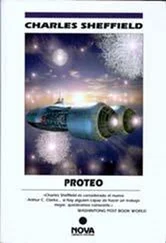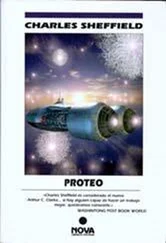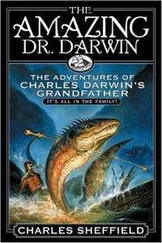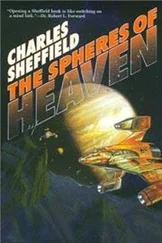* * *
The McAndrew balanced drive.
This device makes a first appearance in the second chronicle, and is assumed in all the subsequent stories.
Let us begin with well-established science. Again it starts at the beginning of the century, in the work of Einstein. In 1908, he wrote as follows:
“We… assume the complete physical equivalence of a gravitational field and of a corresponding acceleration of the reference system…”
And in 1913:
“An observer enclosed in an elevator has no way to decide whether the elevator is at rest in a static gravitational field or whether the elevator is located in gravitation-free space in an accelerated motion that is maintained by forces acting on the elevator (equivalence hypothesis).”
This equivalence hypothesis, or equivalence principle, is central to general relativity. If you could be accelerated in one direction at a thousand gees, and simultaneously pulled in the other direction by an intense gravitational force producing a thousand gees, you would feel no force whatsoever . It would be just the same as if you were in free fall.
As McAndrew said, once you realize that fact, the rest is mere mechanics. You take a large circular disk of condensed matter (more on that in a moment), sufficient to produce a gravitational acceleration of, say, 50 gees on a test object (such as a human being) sitting on the middle of the plate. You also provide a drive that can accelerate the plate away from the human at 50 gees. The net force on the person at the middle of the plate is then zero. If you increase the acceleration of the plate gradually, from zero to 50 gees, then to remain comfortable the person must also be moved in gradually, starting well away from disk and finishing in contact with it. The life capsule must thus move in and out along the axis of the disk, depending on the ship’s acceleration: high acceleration, close to disk; low acceleration, far from disk.
There is one other variable of importance, and that is the tidal forces on the human passenger. These are caused by the changes in gravitational force with distance — it would be no good having a person’s head feeling a force of one gee, if his feet felt a force of thirty gees. Let us therefore insist that the rate of change of acceleration be no more than one gee per meter when the acceleration caused by the disk is 50 gees.
The gravitational acceleration produced along the axis of a thin circular disk of matter of total mass M and radius R is a textbook problem of classical potential theory. Taking the radius of the disk to be 50 meters, the gravitational acceleration acting on a test object at the center of the disk to be 50 gees, and the tidal force there to be one gee per meter, we can solve for the total mass M, together with the gravitational and tidal forces acting on a body at different distances Z along the axis of the disk.
We find that if the distance of the passengers from the center of the plate is 246 meters, the plate produces gravitational acceleration on passengers of 1 gee, so if the drive is off there is a net force of 1 gee on them; at zero meters (on the plate itself) the plate produces a gravitational acceleration on passengers of 50 gees, so if the drive accelerates them at 50 gees, they feel as though they are in free fall. The tidal force is a maximum, at one gee per meter, when the passengers are closest to the disk.
This device will actually work as described, with no science fiction involved at all, if you can provide the plate of condensed matter and the necessary drive. Unfortunately, this turns out to be nontrivial. All the distances are reasonable, and so are the tidal forces. What is much less reasonable is the mass of the disk that we have used. It is a little more than 9 trillion tons; such a disk 100 meters across and one meter thick would have an average density of 1,170 tons per cubic centimeter.
This density is modest compared with that found in a neutron star, and tiny compared with what we find in a black hole. Thus we know that such densities do exist in the Universe. However, no materials available to us on Earth today even come close to such high values — they have densities that fall short by a factor of more than a million. And the massplate would not work as described, without the dense matter. We have a real problem.
It’s science fiction time again: let us assume that in a couple of hundred years we will be able to compress matter to very high densities, and hold it there using powerful electromagnetic fields. If that is the case, the massplate needed for McAndrew’s drive can be built. It’s certainly massive, but that shouldn’t be a limitation — the Solar System has plenty of spare matter available for construction materials. And although a 9 trillion ton mass may sound a lot, it’s tiny by celestial standards, less than the mass of a modest asteroid.
With that one extrapolation of today’s science it sounds as though we can have the McAndrew balanced drive. We can even suggest how that extrapolation might be performed, with plausible use of present physics.
Unfortunately, things are not as nice as they seem. There is a much bigger piece of science fiction that must be introduced before the McAndrew drive can exist as a useful device. We look at that next, and note that it is a central concern of the third chronicle.
Suppose that the drive mechanism is the most efficient one consistent with today’s physics. This would be a photon drive, in which any fuel is completely converted to radiation and used to propel the ship. There is certainly nothing in present science that suggests such a drive is theoretically impossible, and some analysis of matter-antimatter reactions indicates that the photon drive could one day be built. Let us assume that we know how to construct it. Then, even with this “ultimate” drive, McAndrew’s ship would have problems. It’s not difficult to calculate that with a fifty gee drive, the conversion of matter to radiation needed to keep the drive going will quickly consume the ship’s own mass. More than half the mass will be gone in a few days, and McAndrew’s ship will disappear from under him.
Solution of this problem calls for a lot more fictional science than the simple task of producing stable condensed matter. We have to go back to present physics and look for loopholes. We need to find inconsistencies in the overall picture of the Universe provided by present day physics, and exploit these as necessary.
The best place to seek inconsistencies is where we already know we will find them — in the meeting of general relativity and quantum theory. If we calculate the energy associated with an absence of matter in quantum theory, the “vacuum state,” we do not, as common sense would suggest, get zero.
Instead we get a large, positive value per unit volume. In classical thinking, one could argue that the zero point of energy is arbitrary, so that one can simply start measuring energies from the vacuum state value. But if we accept general relativity, this option is denied to us. Energy, of any form, produces space-time curvature. We are therefore not allowed to change the definition of the origin of the energy scale. Once this is accepted, the energy of the vacuum state cannot be talked out of existence. It is real, if elusive, and its presence provides the loophole that we need.
Again, we are at the point where the science fiction enters. If the vacuum state has an energy associated with it, I assume that this energy is capable of being tapped. Doesn’t this then, according to relativity (E =mc 2), suggest that there is also mass associated with the vacuum, contrary to what we think of as vacuum? Yes, it does, and I’m sorry about that, but the paradox is not of my creation. It is implicit in the contradictions that arise as soon as you try to put general relativity and quantum theory together.
Читать дальше












